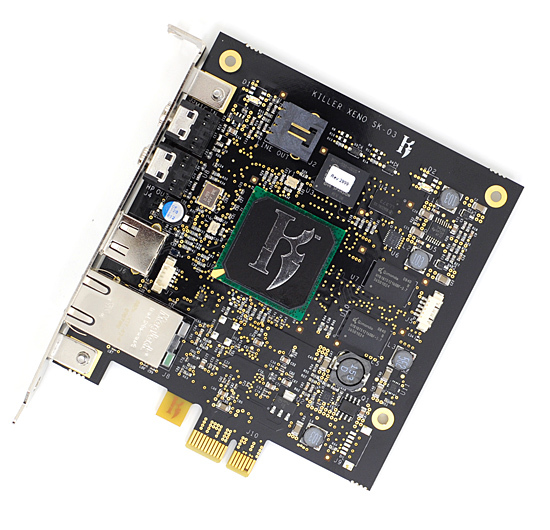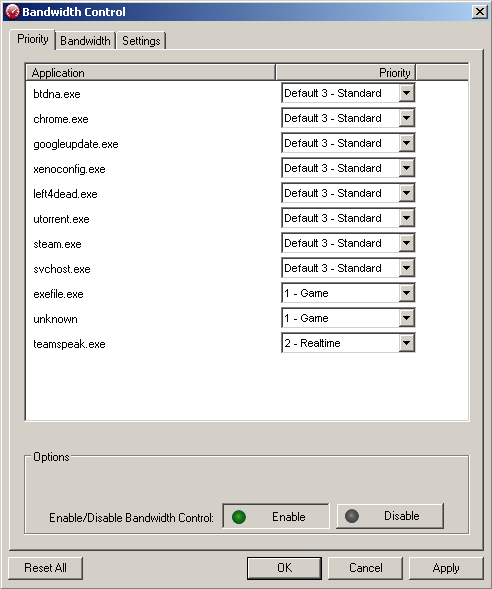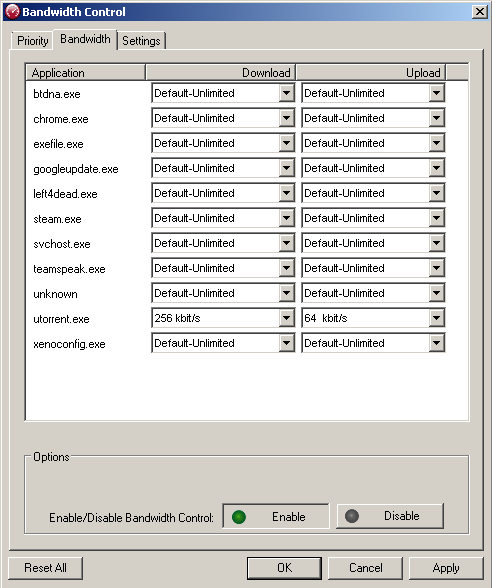EVGA Killer Xeno Pro: The Impact of Network Offloading
by Derek Wilson on July 3, 2009 4:20 AM EST- Posted in
- Networking
The Card and Features
This card sports a 400MHz PowerPC processor with 128MB of RAM, essentially making the Killer Xeno Pro a computer on a x1 PCIe board. As with the first generation, the major feature of the Killer Xeno Pro is it's ability to offload TCP/IP work from the CPU by bypassing the Windows TCP/IP stack.
Microsoft's built-in TCP/IP stack requires the CPU to handle network packet processing. Additionally, when packets arrive, they don't generate interrupts and applications must poll for data (which also wastes time and resources). Bigfoot Networks claims that the windows networking stack is not designed for low latency operation while the Killer Xeno Pro is. Regardless of how (or how efficiently) a software network stack is implemented, having it run in hardware will reduce overhead and impact on the rest of the system. It should also be noted that, for applications which require the windows networking stack (like some VPN products), the Killer Xeno Pro can disable it's "game mode" and enable "application mode" which does disable TCP/IP offload and can increase compatibility in some cases.
Adding to this, the Killer Xeno Pro hardware is capable of offloading other network centric tasks like VoIP, firewalls, and networked storage (though these features are not all fully supported with appropriate software at this point in time).

Installing the hardware is very straight forward, as it's just a simple PCIe card. If you want to use the voice chat features, the only additional need is to connect either the internal or external audio cable. No power is required, and other than that the network port is all that you'll need to worry about. Despite the fact that there is a USB port on the card, it is not used for anything at this point (but Bigfoot has indicated future potential to enable hardware managed USB attached storage).

Mic in and audio line out on a NIC; now that's a first.
The only installation issue we noted is that the driver install, when necessary, will also flash the Killer Xeno Pro hardware. There isn't very much warning about what's going to happen and no confirmation dialog before the start of the flash process. Those who click through install programs quickly without reading them might get themselves into a bit of trouble. There is no way to cancel the flash update once it's started, and while flashing hardware isn't as risky these days, it might be nice if the drivers were a little more clear about what was going to happen.

Easy mode switching.
The hardware comes with drivers and a tray application that are capable of bandwidth throttling and prioritization. Control can be down to a per application basis and maximum download and upload speeds can be specified. Or for benefit without the headache, applications can be prioritized allowing hardware and usage patterns to determine effective bandwidth. Unfortunately, the drivers and applications for the Killer Xeno Pro only run on Microsoft Windows operating systems (XP and Vista flavors). With the gaming focus, this makes sense, but it would still be nice for those who like to dualboot Mac OS X or Linux.

Per application QoS.

Per application bandwidth limits.
With software support, games and voice chat software can completely delegate any VoIP functionality to the Killer Xeno Pro which would handle taking input from the microphone (which plugs straight into the Killer Xeno Pro), compressing the data and sending it out over the network. When a voice packet is received by the Killer Xeno Pro, it decompresses it and sends it straight to the sound card (either via the soundcard's line-in port or an internal cable) bypassing the rest of the system completely. This should help reduce CPU overhead and voice lag caused by sources other than the network or server.
While this is great from a geeky technical standpoint, there isn't a huge amount of overhead on modern CPUs for voice chat software, and the network is by far the largest source of delay. So the actual benefit isn't going to be huge. These issues are the same with hardware firewall, bandwidth control, and all the extras.
The TCP/IP offload capability of the hardware will definitely remove another task from the CPU and operating system. This will free up resources that could be useful for other things, but the real world benefit of this will be very small in most games where the majority of the work is done on the GPU rather than the CPU. Having an NPU (network processing unit, as Bigfoot Networks likes to call it) that handles TCP/IP processing as soon as packets are received and uses hardware interrupts to let a game know that network packets have arrived (rather than requiring polling) can help decrease the latency between when a packet is received by the network card and when a game is able to make use of it, but as with the voice issue the largest delay is inherent in the internet itself and there is only so much benefit that can be had by optimizing the client side.
Not to say that optimizing client side networking is a bad thing: it certainly is not. The real question here is not whether the Killer Xeno Pro does something useful (because it does), the question is whether that useful thing has any significant impact on experience (and if that impact is high enough to justify the price).










121 Comments
View All Comments
Exar3342 - Monday, July 6, 2009 - link
It is interesting how they don't note any of this information on the box, in the marketing information, or on the EVGA website for the card. This sounds like one of those "bad suprises" you get AFTER you waste your money on this and find out it doesn't do anything. The theme of the review isn't that the product doesn't do what it says it does (it does that well) but that it doesn't make an appreciable difference in the real world. It appears clear this product has paper benefits only, and no real gains anywhere.hooflung - Monday, July 6, 2009 - link
This is not a problem. The linux networking stack is more efficient than the XP stack. Even though the NPU isn't doing it in hardware its still not being done on XP.This is why the whole 'offloading' wording is confusing. The card is bypassing the OS stack, thus 'offloading' it to the card. The card then 'offloads' the UDP and 'some' but not 'all' TCP to hardware routines.
While EVE might use a bit of UDP for non critical things such as polling the market but it doesn't help speed up combat which needs the TCP/IP to poll where your ship is in space, what gun you fired, where your enemy is etc etc etc. If you do not have a constant TCP/IP connection, not UDP becuase UDP doesn't require you to have an active connection, you will be booted off the EVE server.
Its as simple as that. Derek should know that as he said he played EVE for 4 years.
The Card does help somewhat on older PC's since it will bypass the Windows stack but not on newer ones. It also DOES help ping on DSL because of how you can manage the network bandwidth and how it gives UDP priority in game mode.
Moreover, you need to be on a DMZ any time you use this card or the router with screw you over and take any performance you would gain and toss it out the door.
I've been a bigfoot customer and have the M1 in my Phenom II 940.
Rigan - Sunday, July 5, 2009 - link
Just for the record, the USB slot can be seen from the inside Linux install. So yes, it does have a use. And, yes, the thing does allow for the running of Linux apps on the inside Linux box. Works just fine.But, I'd be hard pressed to recommend this thing to anybody. In the world of modern multi-core cpu's the basic premise is rather silly.
DerekWilson - Sunday, July 5, 2009 - link
I might like to try that ... it could be fun to just play with. I mean from an ubernerd standpoint anyway.Is that available via their SDK, or is there some other hacking that needs to be done?
Per Hansson - Monday, July 6, 2009 - link
Why not just buy a decent router that supports OpenWRT and has a USB port instead?Then you have a great little device that supports QoS and whith which you can also download torrents etc while your computer is offline
The only use for the Killer NIC is if the system is really pushing 1gbps of traffic, think file server of very demanding webserver.
But that of course requires that the thing actually does offload the entire TCP/IP stack, and not just UDP (which I'm not 100% convinced it even does yet)
A cheaper NIC by any of the major players supporting ToE would probably be a better choice for the file or webserver of course (Due to more testing being done by their driver development departments)
http://en.wikipedia.org/wiki/TCP_Offload_Engine">http://en.wikipedia.org/wiki/TCP_Offload_Engine
Saying that there may be any benefit at all to doing TCP offload for MMO's and other games which work just fine on dialup still to this day (i.e. less than 5KB in bandwidth requirements) is just plain fraud IMO
But then again all reviews on the top sites including this one has come to the same consulsion so ;-)
titan7 - Sunday, July 5, 2009 - link
Read about why Linux considers these a very bad idea and explicitly won't support them:http://www.linuxfoundation.org/en/Net:TOE">http://www.linuxfoundation.org/en/Net:TOE
A friend bought the previous version. Their lousy drivers would bring down his entire system when doing torrents or even some games (e.g. Company of Heroes: Tales of Valor). No noticeable benefit, but it makes his system unstable.
Stay away from bigfoot (and nvidia) NICs!
DerekWilson - Sunday, July 5, 2009 - link
really, if bigfoot opened up their hardware the objections would fade away...honestly, bigfoot is probably using the linux network stack itself on the killer...
if linux devs could program straight to the hardware, it might really be something they would have more interest in.
davecason - Saturday, July 4, 2009 - link
I suspect that you will find that this sort of card would help a really old system that had PCI more than a new one. Think of it this way: if the task of the integrated network interface card is a burden for the CPU, this thing might actually help. Instead of an i7 chipset and compatible processor, think nForce 4 with an old 1.8GHz Athlon.We use Endace DAG cards at work and they work on basically the same principle: offload the Network work to the card.
http://www.endace.com/dag-network-monitoring-cards...">http://www.endace.com/dag-network-monitoring-cards...
Essentially the card is a computer withing your computer, dedicated to the task. The vendor recently let us know that we could get the same work done with standard gigabit ethernet cards in a more modern server... which supports my theory: not for high-end systems.
aadder - Sunday, July 5, 2009 - link
Hmmm those cards seem rather nice. Any idea where I might be able to buy the Endace DAG card?has407 - Sunday, July 5, 2009 - link
The Endace DAG cards are intended for special-purpose applications. Unless you need high speed capture and analysis, you can do better with lower-cost Intel, Broadcomm, Alactitech, etc. NICs.